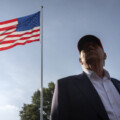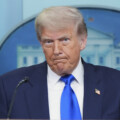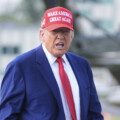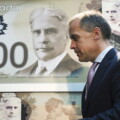Donald Trump’s tariffs on Canadian goods aren’t about stopping smugglers or drugs at the border, or even evening up trade deficits. They’re about money—big money. Trump wants to keep his old tax cut package alive (the Tax Cuts and Jobs Act)—and in fact go further. This week, Commerce Secretary Howard Lutnick stated that Trump’s intention is to eliminate taxes for any American making less than $150,000 per year.
But Trump knows that a pack of hawkish Republicans in Congress will not go along with these ambitious plans without some kind of fiscal offset. And even if they’re prepared to play along, there’s reason to think that markets may not. Significant parts of the TCJA will expire on December 31, 2025, unless Congress passes new legislation.
That’s why he has signaled his intention for significant tariffs on exports from Canada, China, and Mexico–America’s three largest trading partners. By definition, these are where tariffs could generate meaningful revenues.
In Washington, a group of fiscal hawks—folks like Senators Rand Paul, Mike Lee, and Rick Scott, and Representative Thomas Massie—keep a close eye on the nation’s books. They may not be prepared to bless another big round of deficit-financed tax cuts. They could insist that the renewal of the TCJA requires offsetting spending cuts or some sort of new revenues. Trump, who must depend on the Congressional Budget Office for costing his plan, is scrambling for ways to show that he can keep the treasury steady. Hence, his External Revenue Service—a fancy label for tariffs slapped on foreign goods. In truth, it means higher costs for American firms and families. But from Trump’s view, it’s worth the heat if it helps him hold on to a key pledge from his first term.
But it’s not just Congress that is putting pressure on the president to pay for his tax cuts. Markets are signalling for the first time that they won’t go along with Washington’s deficits and debt. The U.S. government is already paying higher borrowing rates than Canada. If it plunges ahead with another round of unfunded tax cuts, it’s quite likely that these rates will continue to go up.
We’ve seen what happens when leaders promise big tax cuts without a plan to cover the bill. Liz Truss, the former British prime minister, tried that trick. She sprang tax cuts on her country and had no backup plan to steady the books. The markets went wild, her own party ran for cover, and she was gone in a blink. No leader wants to repeat that meltdown. Trump’s tariffs are in part a hedge to dodge a similar fate.
Make no mistake, these tariffs are not a small chip. Take Canada for instance. A 25 percent duty on most goods and a 10 percent levy on energy will land like a hammer blow for both sides. We know that Canada sends oil, metals, farm goods, and more to the United States. We also know that jobs and costs on both sides of the border will shift if these new taxes are put in place. But Trump has chosen the path of short-term gain over the medium-term harms to the U.S. economy.
Many in Trump’s party cheer the original tax cuts. They see them as a driver of business growth and a boost to family paycheques. But they also don’t really want to cut spending. So deficit financing has become a way to reconcile big government on the cheap. As markets begin to doubt that fiscal model, tariffs are another way to avoid a more difficult conversation about what Americans want from their government and what they’re actually prepared to pay for.
If anyone thinks these tariffs are only bluster, they should think again. They’re the linchpin of a Republican agenda that needs a new way to reconcile tax cuts and spending growth. Slapping a big, sweeping tax on goods from across the border helps Trump say he’s standing up for the U.S. worker while scooping up much-needed revenues to feed his plan. And if it pulls in enough funds, he can hold up the numbers to the folks on Capitol Hill and the bond markets say, “See? My tax plan pays for itself.”
Of course, the real cost will fall on businesses and folks who buy these goods. Tariffs are a tax on firms and families, on both sides of the border, many of whom might not even notice how prices have crept up. But that’s how it goes in politics. If there’s no public outcry, leaders will do what suits their goals.
Trump isn’t the first politician to do a head-fake with tariffs, and he won’t be the last. But if anyone doubts the true aim of this scheme, the clues are plain to see. We saw how Truss fell when she couldn’t back up her tax plan with meaningful offsets. Trump took note. He won’t let that happen to him. With fresh tariff revenues and a nod from the Congressional Budget Office, he can breeze ahead with the next wave of tax relief and keep his party’s fiscal hawks and the bond vigilantes at bay.








